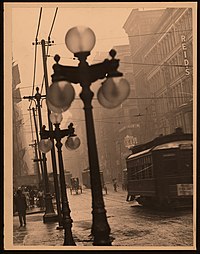American urban history

Okay, kiddo, so you know how we live in a city, right? Well, a long time ago, cities looked very different.
Back then, most people lived in rural areas, which means they lived in the countryside and worked on farms. But as time went on, things started to change. People realized that they could make money by building factories and making things like clothes and machines.
So, they started building cities in places where there were factories. People moved from the countryside to the cities to work in the factories. This was the start of urbanization.
At first, cities were pretty small and only had a few buildings. But as more and more people moved to the cities, they grew bigger and bigger. Soon, there were skyscrapers that reached the clouds!
As cities grew, people started to realize that they needed things like schools, hospitals, and parks. They also needed a way to get around, so they built roads and bridges. This was the start of what we now call urban planning.
But living in a city wasn't always easy. In the early days, there wasn't a lot of housing, so people had to live in crowded tenements or apartments. These were often dirty and unsafe.
Over time, things started to improve. Laws were passed to make buildings safer, and more affordable housing was built. People started to realize that cities could be great places to live, work, and play.
Today, American cities are thriving. They're full of amazing architecture, museums, and restaurants. They're also home to some of the biggest companies in the world, like Amazon and Google.
So that's the story of American urban history, kiddo. It all started with factories, grew with urban planning, and overcame challenges to become the wonderful cities we know today.
Back then, most people lived in rural areas, which means they lived in the countryside and worked on farms. But as time went on, things started to change. People realized that they could make money by building factories and making things like clothes and machines.
So, they started building cities in places where there were factories. People moved from the countryside to the cities to work in the factories. This was the start of urbanization.
At first, cities were pretty small and only had a few buildings. But as more and more people moved to the cities, they grew bigger and bigger. Soon, there were skyscrapers that reached the clouds!
As cities grew, people started to realize that they needed things like schools, hospitals, and parks. They also needed a way to get around, so they built roads and bridges. This was the start of what we now call urban planning.
But living in a city wasn't always easy. In the early days, there wasn't a lot of housing, so people had to live in crowded tenements or apartments. These were often dirty and unsafe.
Over time, things started to improve. Laws were passed to make buildings safer, and more affordable housing was built. People started to realize that cities could be great places to live, work, and play.
Today, American cities are thriving. They're full of amazing architecture, museums, and restaurants. They're also home to some of the biggest companies in the world, like Amazon and Google.
So that's the story of American urban history, kiddo. It all started with factories, grew with urban planning, and overcame challenges to become the wonderful cities we know today.
Related topics others have asked about:
